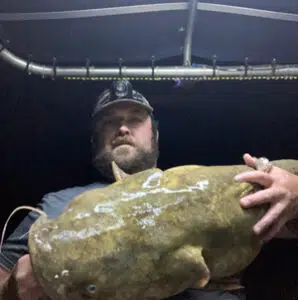PLEASE SHARE
WE ARE YOUR SOURCE FOR FISHING DESTINATIONS IN ALABAMA!
Fall Catfishing for Trophy Flatheads on Lay Lake

Apex predators, flatheads don’t conform to catfishing stereotypes. This is where and how these big fish are targeted on Lay Lake.
By Eileen Davis
Now that fall has arrived, flathead catfish are on the prowl and have become voracious feeders. Unlike blue cats that feed through winter, flatheads become dormant when water temperatures fall into the 40s, so flatties must fatten up before winter arrives. For that reason, avid yellow cat anglers fish as often as possible during fall.
One angler who fishes for flatheads whenever he can is Marshall Hughey of Deatsville. Hughey is the founder and director of the Alabama Catfish Series, which holds tournaments across central and south Bama. He also competes in national tournaments.
“I am obsessed with catching trophy flatheads,” Hughey said. “They are the apex predators of freshwater. Usually, flatheads only consume livebait and will eat anything alive, even other catfish.”
With Hughey living near the Alabama River, he spends a lot of time there, but Lay Lake on the Coosa River is his favorite for catching flatheads.
“Lay Lake is diverse,” Hughey said. “The upper lake is riverine, and the lower lake has submerged river channels and expansive open stump fields. There are flats full of structure next to deep water. Additionally, these areas hold a lot of bait fish. I fish between the steam plant and Bozo’s Fish Camp.”
Collecting Livebait
Before fishing for flatheads, Hughey first collects big, aggressive livebait.
“Flatheads are peculiar about bait,” he said, “so I like to offer them an appetizer platter of bream, redhorse suckers, gizzard and threadfin shad. If they don’t like what you are offering, you have the option of switching baits to find what works.”
As required by the Department of Conservation and Natural Resources, Hughey catches bluegill and shellcracker with hook and line, which he baits with crickets or worms. He catches shad and suckers with a cast net.
Before Hughey began using Lowrance ActiveTarget, he found shad by watching them flipping on the surface near grass mats. Some days, though, shad would not be visible on the surface.

“One thing I can say about catfishing,” Hughey said, “as anglers, we spend more time catching bait than we do fishing for catfish. When bait is hard to find, you can put in some serious time gathering bait to go fishing for a few hours. To keep them lively, I use a 20-gallon X-Treme Bait Tank.
“I purchased ActiveTarget for catching bait. With it, I can now find bait fish fast, and I can even watch the castnet descend over them. So with only one or two throws of the net, I have all the bait I need. Live sonar is a game changer.”
Finding Flatheads
To find flatheads, Hughey looks for deep holes next to flats 5 to 7 feet deep. Deep holes with logjams are ideal habitat for these brutes in summer. For fall, these deep holes need to have cover on the slopes leading to flats.
“I have two places to fish,” Hughey said. “I have the flats and the slopes next to the flats. During fall, flatheads move about halfway up in the water column towards the shallows. For example, if the hole is 40 feet deep, you will find the fish about 20 feet deep in cover on the slope. They stack up on the slopes so they can run to the flats to ambush bream and shad.”
With the range set to 60 feet, Hughey uses side scan sonar to find logs, snags and stumps on the slopes.
Boat Position
Boat position is critical to Hughey’s success as it allows him to fish the cover on the slope and the flat at the same time.
“Drop a waypoint where you want to fish,” he said. Then consider how wind and current will affect the boat at anchor and move up to where you need to drop the anchor. Release enough anchor rope so you are within casting distance of your target.
“I fish four to six B’n’M rods with Penn reels off the back of the boat. This allows me to spread my baits out from the flats on one side of the boat over to the deeper water on the slope. This setup is effective, so if during a tournament I do not get a bite within 30 minutes, I will move.
Fishing Livebait
Hughey spools his size 40 Penn Squall reels on one piece 7-foot, 6-inch B’n’M Silver Cat Magnum rods with 40- or 60-pound K9 “9” Strand Super Braid. He threads the braid though a sinker slide for a bank or pyramid sinker before attaching a swivel.
Hughey pre-ties 80- or 100-pound-monofilament leaders in lengths of 2 to 6 feet. For leaders destined for shallow water he uses 8/0 or 10/0 Boss Kat BIG BOSS “J” hooks. Hughey ties Boss Kat HD SUPER BOSS circle hooks in sizes up to 12/0 on the remaining leaders.
“In my experience,” he said, “circle hooks don’t work well in shallow water. The fish do not have the depth to swim and load the hook. When I am fishing deep, I use a circle hook because the fish can hook themselves.
“As for leader length, select a leader that keeps your bait in front of the fish. For example if you are using a 4-foot leader and not catching fish, maybe your bait needs to be closer to the bottom. In that case, switch to a 2-foot leader.
“When necessary, I also use slip bobbers on my leaders to float my baits off the bottom. The size of the bobber depends on the bait. A big gizzard shad requires a much larger bobber than a small threadfin.”
Hughey no longer has to guess about the location of his baits. He points his ActiveTarget transducer at the baits and watches them in real time. Not only does the live sonar show the baits in relation to the bottom and cover, it also shows how fish react to the baits.
“Before I had ActiveTarget,” Hughey said, “I did not realize how often a fish would swim up to the bait, smell it, and leave. Just because the bait is still on the hook after a long soak, it does not mean the area is without fish.
“One thing that has made a big difference in my catch rate is to cut the tails of the bait off with scissors. The bait is going to die quicker, but it makes the bait injured, bleeding and in a panic. This makes them an easier target for flatheads and results in faster bites. Also, if you leave the tail on a bluegill or shellcracker, they will wrap you around a log.”
For more information on fishing The Alabama Catfish Series, visit the trail’s FaceBook page.
Click here to read more about how successful anglers find and catch Bama’s bass.
